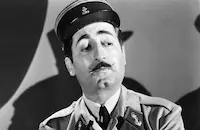To the Victor
Brief Synopsis
Cast & Crew
Delmer Daves
Dennis Morgan
Viveca Lindfors
Victor Francen
Bruce Bennett
Dorothy Malone
Film Details
Technical Specs

Synopsis
At a Paris airport, police captain Beauvais arrives with the traitor Lestrac in his custody. A short time later, Christine Lund is pursued by two men who are trying to kill her. To escape them, she runs into the American Hotel, but is followed by Nikki, one of the men. At the hotel, Paul Taggart, an American black marketeer, tries to pick her up, but she rebuffs him. Later, when she learns that Lestrac has been captured, she begs Paul to help her. He knocks Nikki unconscious and helps Christine escape. Before he drops her off, he asks for her address. He then stops at the apartment of his partner Steve and tells Steve's wife Gabby to check out and bring her baby to his hotel, because the police are about to expose Steve's activities. When Paul later goes after Christine, he discovers that she gave him a false address. Meanwhile, Christine goes to the studio of her friend Pablo, a painter, where Beauvais is waiting. He has made arrangements for Christine, who is Lestrac's wife, and Pablo to go to Normandy until Lestrac's trial to prevent Lestrac from having her killed so that she cannot testify against him. When Paul arrives home, the police are there looking for Steve, who tries to shoot his way out and is killed. Now that Steve is dead, Paul sends Gabby and the baby to Steve's parents in the United States. At the station, Paul sees Christine board a train, followed at a distance by Nikki. Paul takes the train as well and warns Christine. Together with Pablo, Paul plots to evade Nikki, and the trio arrives in Normandy safely. In Normandy, Paul and Christine fall in love, even though they know nothing about each other. Pablo, who knows about Christine's past, disapproves of their romance. Later, their hideout is discovered by Firago, Lestrac's ally. Although Christine has already left, Firago tells Paul about her husband and adds that she was a Nazi collaborator. Vainly hoping that Paul will not learn about her past, Christine tries to make a deal with Geran, Lestrac's lawyer, but Beauvais puts an end to the plan. Beauvais then talks to Paul and tells him that in his opinion, a black marketeer is just as bad as a traitor. He declares that both Paul and Christine have obligations to fulfill before they can go on with their lives. Later, Firago offers Paul passage to the United States if he will take Christine away with him before Lestrac's trial. Paul then accepts a large sum of money from a former Nazi, who wants to buy coal on the black market, and asks Christine to leave with him that night. With the help of his friends, Paul, who is certain that Christine will stay in France and testify against her husband, sets a trap for his allies in the black market, as well as Firago's men. As hoped, during the ensuing gunfight, all are killed. Later, Christine testifies in court while Paul watches.

Director

Delmer Daves
Cast

Dennis Morgan

Viveca Lindfors

Victor Francen

Bruce Bennett

Dorothy Malone

Tom D'andrea

Eduardo Ciannelli

Douglas Kennedy

Joseph Buloff

William Conrad
Luis Van Rooten
Konstantin Shayne

Anthony Caruso
Joanee Wayne
John Banner
Henry Rowland
Felipe Turich
Louis Mercier
George Sorel
Alfred Paix
Lottie Williams
Ray Montgomery
Dick Walsh
Clyde Cook
Jean Debriac

Marjorie Bennett
Torben Meyer
Marcelle Corday
Marcel De La Brosse
Alex Akimoff
Jacques Villon
George Davis
Paul Bryar
Fred Marlowe
Kurt Furberg

Denise Darcel

Paul Panzer
Crew
Milo Anderson
Folmar Blangsted
Richard Brooks
Robert Burks
David Buttolph
Leo F. Forbstein
Oliver S. Garretson
Marcel Grignon
Ana-marie Joel
Bill Kissel
William Kuehl
Leo K. Kuter
Louiguy
Edith Piaf
Leonid Raab
Jerry Wald
Perc Westmore

Film Details
Technical Specs

Quotes
Trivia
Notes
This film marked Viveca Lindfors' American film debut and the motion picture debut of Denise Darcel. A April 19, 1948 article in Time notes that the film was made in France with "36,000 French-frozen Warner dollars." According to a September 21, 1947 New York Times report, director Delmer Daves shot two-thirds of the exteriors in France with the principal actors. The other third of the exteriors were static closeups, which were used as process shots in the background. At Omaha Beach in Normandy, for example, the arrival and departure of the actors was shot at low tide in order to reveal the tanks and ships abandoned during the invasion. Plates were then made while the tide was still out and were used behind the actors in closeups, so that the production would not be disrupted by tidal changes. Daves also used French doubles in some of the Parisian long shots. The New York Times review commented unfavorably on the obvious differences between the location scenes in Paris and Normandy and the rest of the film, which was shot on a sound stage.












